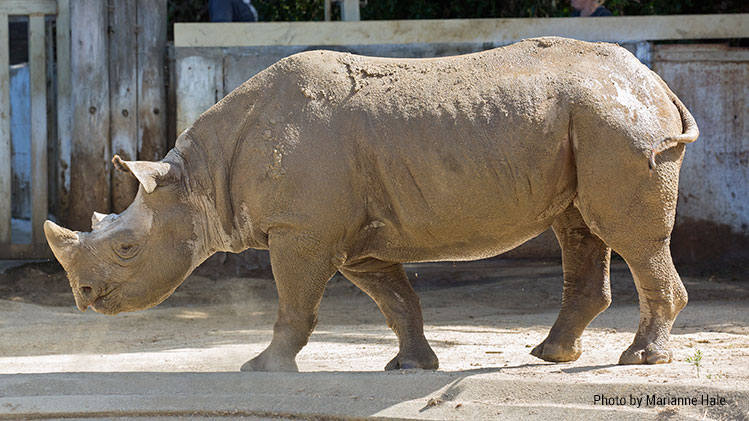Black Rhinoceros
Diceros bicornis

At the Zoo
Our black rhino can be found across from Cat Kingdom, and next to the pygmy hippopotamus.
The Zoo’s male black rhino is named “Boone,” after the San Francisco 49ers’ former right tackle, Alex Boone.
Fascinating Facts
- Black rhinos can move at speeds up to 40 miles per hour for short distances!
- Like horses, rhinos run and walk on their toes.
- Both the black rhino and white rhino are grey in color; color can vary as rhinos take on whatever color mud they happen to have rolled in.
Physical Characteristics
An adult black rhinoceros can weigh up to 3,000 pounds with a body length of 10 to 12.5 feet. A thick, wrinkled, tough hide protects the rhino as it pushes its way through the thorny acacia trees and bushes it likes to eat. The rhino uses its prehensile upper lip to strip nutritious leaves off tough branches.
The black rhinoceros is distinguished by two large horns on its nose, the front one being the largest. These horns can measure up to 50 inches in length and are made of hardened compressed hair-like fibers on a bony base. They have small eyes and are extremely nearsighted, making the rhino dangerous and unpredictable, and likely to charge unfamiliar sounds and smells. However, their excellent sense of smell gives them information about their surroundings and helps them detect danger. They have prominent, erect ears that can swivel to pick up even the quietest sounds.
Life span is 35-50 years in the wild.
Habitat/Diet
Black rhinoceros range in eastern and southern parts of Africa (South Africa, Namibia and Zimbabwe), inhabiting bushy plains, dense brush, open forests, grassy plains and sometimes semi-arid regions. Nearby access to water is essential as they often spent part of the day resting in water.
Black rhinos are herbivores and are browsers, not grazers. In the wild, they eat bushes and shrubs, preferring acacia, twigs and new growth. At the Zoo, the rhinos are fed a diet of alfalfa, hay, fruits, vegetables, browse and acacia.
Social Behavior
Although black rhinos use several different vocalizations, they typically rely more on scent marking to communicate. By urine-spraying shrubs and rocks and also using communal dung heaps rhinos mark their trails and territory borders.
These rhinos feed in the morning and evening and sleep in the shade or in a wallow during the hottest part of the day. Wallowing in mud helps to keep them cool, and gives them protection from flies and biting insects. Rhinos are often accompanied by tick birds and cattle egrets, which feed on insects stirred up by the rhinos’ feet.
Black rhinos are solitary animals, only coming together to mate. Breeding occurs throughout the year although males do not reach sexual maturity until 10-12 years of age and females 6-7. One calf is born after a gestational period of 419-478 days. Calves will stay with the mother for up to three years, with weaning beginning around two months.
Status In The Wild
Black rhinos are Critically Endangered. Before 1960, the population of black rhinos throughout the eastern and southern parts of Africa was approximately 200,000. Due to large-scale poaching, 90% of the rhinos in existence have now been killed. There are more than 5,000 wild black rhinos alive today, an increase from low numbers due to aggressive conservation efforts, and many of those are protected by armed guards.
Rhinoceros horns are highly valued by some cultures for traditional medicines and for decorative dagger handles. As a result, the black rhino has been hunted nearly to extinction. Rhinoceros populations have also come under pressure as a consequence of bush clearing for agriculture and firewood.
The Zoo manages its black rhinos under the Association of Zoo and Aquarium’s Species Survival Plan for Black Rhinos.
What can you do to help black rhinos?
- Don’t support illegal trade by purchasing anything made from rhino horn.
- Consider donating to conservation organizations and programs like the Black Rhino Range Expansion Project and 96 Elephants.
- Spread the word about rhino conservation!
